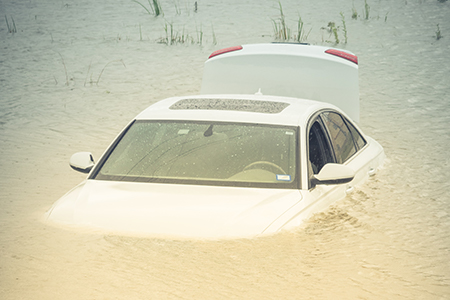What You Should Know During and After a Flood
Turn Around, Don’t Drown
In direct response to so many unnecessary vehicular-related flood deaths, the National Weather Service developed a national campaign called, “Turn Around, Don’t Drown.” Follow this motto by doing the following:
- If flooding occurs, get to higher ground. Get out of area prone to flooding, including dips and low spots in roadways.
- Avoid roads that are already flooded by finding detours. In Bryan, check the Road Closure Map to see roads that have been reported as flooded.
- If heavy rain is coming, move your vehicles away from streams and washes.
- Be cautious, especially at night when it is harder to recognize flood dangers.
Hazards in Water
Flood waters contain many things that may harm health. We don’t know exactly what is in floodwater at any given point in time, so it’s best to avoid it. According to the Centers for Disease Control, flood water can contain:
- Downed power lines
- Human and livestock waste
- Household, medical, and industrial hazardous waste (chemical, biological, and radiological)
- Coal ash waste that can contain carcinogenic compounds such as arsenic, chromium, and mercury
- Other contaminants that can lead to illness
- Physical objects such as lumber, vehicles, and debris
- Wild or stray animals such as rodents and snakes
Additional exposure to contaminated flood water could cause wound infections, skin rash, gastrointestinal illness or tetanus. It is important to protect yourself from exposure to floodwater regardless of the source of contamination. The best way to protect yourself is to stay out of the water.
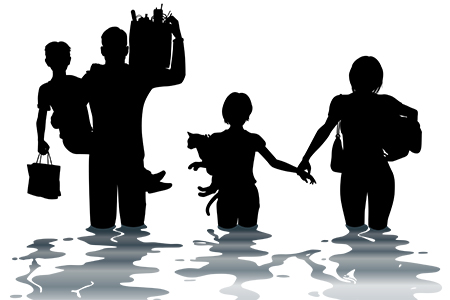
If you come in contact with floodwater
- Wash the area with soap and clean water as soon as possible. If you don’t have soap or water, use alcohol-based wipes or sanitizer.
- Take care of wounds and seek medical attention if necessary.
- Wash clothes contaminated with flood or sewage water in hot water and detergent before reusing them.
If you must enter floodwater, wear rubber boots, rubber gloves, and goggles.
Electrical Safety in Water
- Don’t step into a flooded room if the water may be in contact with electrical outlets, appliances or cords. The water could be energized and could shock or electrocute you.
- Never attempt to turn off power at the breaker box if you must stand in water to do so. If you can’t reach your breaker box safely, call BTU at 979.821.5700 to shut off the power at your meter.
- Avoid using electrical appliances or touching electric wires, switches and fuses when you’re wet or standing in water.
- Keep electrical tools at least 10 feet away from wet surfaces, and do not use electric yard tools if it is raining or wet.
- If an electrical appliance has been in contact with water, have it checked by a professional before using it.
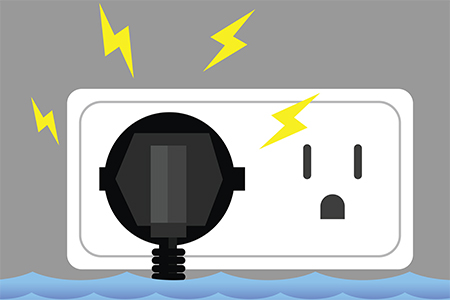
Water and electricity don’t mix well. Always err on the side of caution when flooding occurs near electricity.
Mosquito Infestations
When standing water persists after a flood, the number of mosquitoes can suddenly increase. They need the standing water for breeding and can do so in even very small amounts of water. Floodwater mosquitoes deposit their eggs on the soil in areas that are flooded, and the eggs hatch 5 to 7 days later – which results in large swarms of mosquitoes during the warmest times of the year.
To help reduce the spread of mosquito-borne illnesses:
- Drain wet areas and puddles of eater, or fill them with dirt to eliminate the standing water.
- Empty or drain the water from damaged materials that aren’t usually outdoors, such as furniture trash and fabric items.
- Get rid of standing water in rain gutters, old tires, buckets, toys, pools or other containers.
- Use insect repellents containing DEET.
- Avoid going outdoors during dusk and dawn, and wear long sleeves and pants, when possible.
- Keep mosquitoes outside by repairing doors and screens, keeping doors – including garage doors – closed, and use air conditioning when possible.
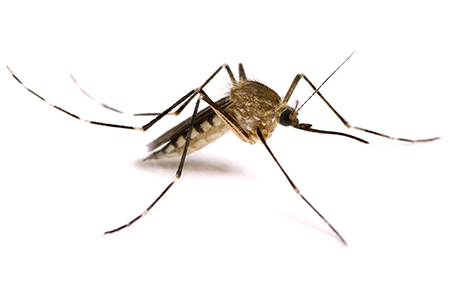
Generally, a limited number of mosquito plunks and dunks are available to assist with treating mosquito breeding grounds. Residents can receive them by visiting the Municipal Services Center, 1111 Waco St., between 8 a.m. and 5 p.m. Monday through Friday.
Dealing with Post-Flooding Mold
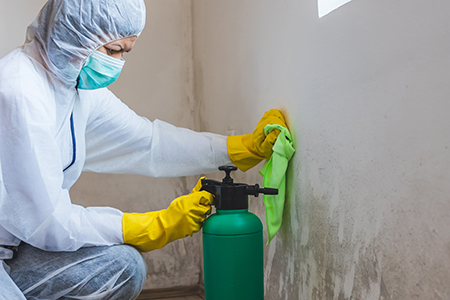
Cleaning mold
Follow these tips to clean up mold properly after a flood:
- Protect yourself: Put on personal protective equipment (gloves, mask and goggles) to protect your eyes, nose, mouth and skin.
- Toss it: Anything that was wet with flood water and can’t be cleaned and dried completely within 24 to 48 hours should be taken outside.
- Air it out: Open all doors and windows when you are working, and leave as many open as you safely can when you leave.
- Circulate: When electricity is safe to use, use fans and dehumidifiers to remove moisture.
- Don’t mix cleaners: Mixing cleaners such as bleach and ammonia can create toxic fumes and vapors.
- Scrub surfaces: Clean them with water and a detergent. Remove all mold you can see and dry the area right away.
- Remove it: Painting or caulking over mold will not prevent it from growing. Fix the water problem completely, and clean up all mold before you paint or caulk.
Handling Trash and Debris After a Flood
When areas are flooded, you may have extra trash and debris as a result. And, Bryan’s solid waste crews want to help make cleanup as easy as possible.
After a flooding event, the city’s Solid Waste Department will accept a manageable amount of damaged items and debris. They will collect that debris and trash as they are able to while still being able to provide normal trash services to the community.
- Post-flooding trash collection does not have any additional costs to residents and is offered as an immediate cleanup service for a limited amount of time after a flooding event.
- Place bulky damaged items such as carpet, sheet rock and furniture at the curb on your normal brush and bulky pickup day.
- Downed trees and brush should be collected and placed on the curb on your normal brush and bulky pickup day.
- Crews cannot accept hazardous waste during post-flooding cleanups. Hazardous items must be disposed of by contacting a special waste hauler or on the Twin Oaks Household Hazardous Waste Disposal Days in April and October each year.
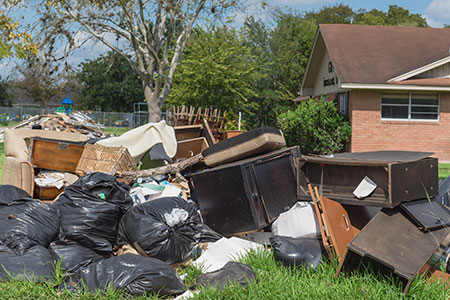
Anyone with questions about trash and debris after a flooding event should call the Public Works Call Center at 979.209.5900.
